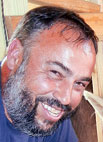
Dwight and Sandy Bartholomew have a cow/calf operation in addition to a cattle order buying business, with Sandy doing the bookkeeping. When Dwight considers his operation, he deeply believes that the choices people make are found within their heritage.
Both his father’s side of the family and his mother’s were among the founding families in Washington County, Ark., though none of the original land from the early 1800s is still in his hands.
Loyd Hawley is a local professional genealogist whose passion originated while raising a dairy herd and keeping track of their genetics. He is steeped in the early history with Dwight being one of many clients and provided the following information.
Dwight is the 11th generation of his family to live in the U.S. and the sixth in Washington County. One of the ancestors on his mother’s side was John Rutherford, who appears on the 1828 tax list for Washington County, making him one of the very first settlers. Another ancestor on his mother’s side was Arthur Carney, a Revolutionary soldier who settled here with his extended family in 1836. The time frame was an interesting period because people knew the Cherokee in Washington County were going to be moved to Oklahoma and were waiting to take their land.
The Bartholomew side of the family came from Ireland in 1700 and settled in Pennsylvania. Dwight’s great-great grandfather, William Scott, served in the Civil War and received 160 acres in Strickler, Ark., through the Homestead Act, which was intended to encourage Western migration.
These early settlers ran subsistence style farms with chickens, a dairy cow, one or two head of beef cattle because there was no place to sell calves in the undeveloped land and as many as 10 pigs. The beef cattle probably started out as Longhorns crossed with Herefords and dairy cows, which gave birth to commercial herds and hybrid vigor.
What all of this means in terms of people’s decision-making, is that people like Dwight come from a long line of farmers who responded to changing conditions.
Dwight’s grandfather, William Bill Bartholomew, continued the tradition of being the Strickler Postmaster and ran the Strickler store, which served as a trading center. During the late 1920s, his grandfather had a truck route and sold items traded at the store.
In 1936, he began as co-owner of the Washington County sale barn which Dwight’s father, Argil, continued.
“The most important thing I learned about the cattle business from my father was the value of the animal and their genetics,” Dwight said. “For example, I might have a good Hereford calf that would thrive better further west in order to avoid summer pinkeye problems and toxic fescue pastures here. Relocating that calf makes sense while keeping another whose genetics indicate better growth and health here also makes sense. Different animals have different values to different people.”
Like his dad, Dwight and his brother were in the sale barn business for years and also did order buying for people both in and out of the area. Eventually, Dwight left the sale barn business and recently has others fill orders for him. With that shift the order buying business decreased to only 25 percent of his cattle operation, while the 75 percent majority is a cow/calf operation.
“I find the cow/calf business is easier for me to manage,” Dwight said.
Dwight has three herds in the area. One has black cows, another is Red Angus, and another is black baldies. He keeps them separated in different pastures. Last year, he bought heifers to breed and sell. He retained some which are now beginning to have calves. The herd is bred by three registered black Angus bulls.
Dwight selects bulls, cows and heifers according to EPDs looking for birth weights, milkability and weaning weights. He prefers early spring calves because the mommas are getting good grass and will therefore produce more and better quality milk. In addition, milk production will stay up for the next calf.
Dwight prefers large pastures to rotational grazing and controls grass height by varying the amount of 16 percent commodity mix grain he gives his animals. The purpose is to keep the pasture viable while not allowing fescue to grow too high and become an issue. The pastures are 80 percent fescue and 20 percent Bermuda, with some volunteer clover that Dwight protects by careful spraying using the boom sprayer mostly when the ragweed gets thick enough. He spot sprays and has the worst problems with thistles and honey locust. The pastures are fertilized with both commercial fertilizer and chicken litter as indicated by soil testing every three or four years.
Bred heifers are grained with 5 to 6 pounds per head per day with most of them weighing 1,100 to 1,200 pounds, while cows receive 3 pounds per day. The bulls receive 6 pounds per day in addition to pasturing to maintain their health.
Dwight pays someone to bale his hay and additionally purchases mixed grass hay both locally and out of state.
“Hay markets fluctuate and paying attention to the markets in different places makes sense,” Dwight’s said. “In all aspects of my operation I go where the opportunity seems best and my heritage provided me with the knowledge I needed to prosper.”







